ภาพรวมรายงานของมูลนิธิ Ethereum ปี 2024: ระดมทุนได้เท่าใดและใช้จ่ายไปที่ใด?
Original title: Ethereum Foundation Report
Original author: Ethereum Foundation
คำแปลต้นฉบับ: Odaily Planet Daily Husband How
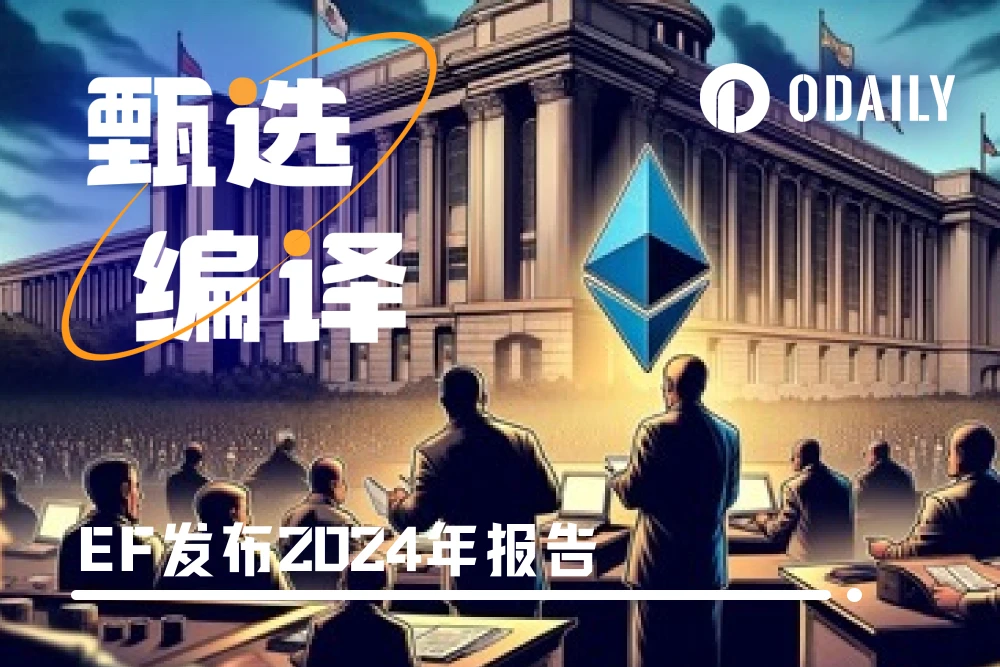
What is the Ethereum Foundation?
The Ethereum Foundation (EF) is a non-profit organization that supports the Ethereum ecosystem and is part of a community of organizations, individuals, and companies that fund protocol development, grow the community, and promote Ethereum.
EF is at the forefront of a new type of organization: supporting the blockchain ecosystem without controlling it. This makes everyone think every day about what kind of organization EF needs to be to support the long-term development of Ethereum.
EF itself is divided into many individual teams and believes that small autonomous teams are the most efficient structure to get work done. New teams often grow organically by forking existing teams in response to new needs of the ecosystem.
EF teams contribute to many different parts of the Ethereum ecosystem. Some teams build software or explore the frontiers of the Ethereum roadmap; some help foster an ecosystem of developers and users around the world; others help educate the world about the utility and potential of Ethereum.
Core Values
Over the past 10 years, EF has experienced the ups and downs of Ethereum鈥檚 short history.
This experience taught us many lessons. Over time, three key ideas emerged that helped แนะนำ EF and inform our decision making.
These are our three core values: long-term thinking, subtraction, and values management.
Long-term thinking
Ethereum is still young, and the ecosystem sometimes focuses on very short-term goals and cycles. EF should balance this tendency: look beyond the peaks and troughs of market cycles and focus on the long-term outlook. This means that EF is willing to take actions now that may not pay off in years or decades, or even take actions that will not have any effect.
Subtraction
Subtractive means we do not try to accumulate power and prestige. Our success is measured by what the Ethereum ecosystem achieves, not what EF achieves. We are happy to give credit to others, support independent organizations, and work quietly behind the scenes.
Subtraction stems from an observation: organizations – non-profit organizations – naturally desire to accumulate power. But this cannot happen to organizations like EF that support decentralized blockchains. In order to counter this default path, EF needs to take active measures.
Value Management
Ethereum is more than just a technology. It is a community bound by a set of shared values and a vision of how those values can improve the world. The Ethereum ecosystem stands on the shoulders of a long history of open source and cypherpunk communities that paved the way for us.
EF Activities and Expenditure
Ethereum Foundation Team
EF includes many teams that contribute to the Ethereum ecosystem, covering a wide range of areas. Most teams contribute to important Ethereum infrastructure, while a few others research and manage the Ethereum roadmap, or help coordinate the ecosystem. Team examples are as follows:
-
Robust Incentives Group (RIG): Dedicated to Ethereum mechanism design and การเข้ารหัสลับeconomics research. RIG鈥檚 work characterizes all the ways incentives directly or indirectly affect Ethereum users and protocol stakeholders. Where possible, RIG proposes mechanisms to restore incentive compatibility and system optimality.
-
Protocol Support Team: The Protocol Support Team ensures that Ethereum has the right people, processes, and perspectives to support its long-term maintenance. In practice, this team helps promote network upgrades (AllCoreDevs, EL Specification), attract and retain protocol contributors (Ethereum Protocol Scholarship), and undertakes various other projects related to the sustainable development of Ethereum.
-
Developer Conference (Devcon): Host and support events such as Devcon to promote collaboration, education, and promote Ethereums values and mission. As the community grows, the team expands Ethereums global influence through community-driven gatherings such as Devconnect, support for non-EF events around the world, and regional programs such as the Road to Devcon grant program.
Ethereum Foundation Funded Projects
EF supports important work across the ecosystem through grants. Grants come in many sizes and forms, and many EF teams play a role in approving and evaluating grants. The Ecosystem Support Program (ESP) regularly reports on grant activity. Grant examples:
-
WTF Academy: WTF Academy produces free, open source, concise, and community-reviewed tutorials on Web3 development tools, including Solidity, Ethers, and more, with a focus on Chinese content. ESP funding helped them expand their courses and translate more content into English. $30,000 in grants awarded in November 2022.
-
Security Alliance: The Security Alliance is dedicated to creating a more secure ecosystem. They do this through projects such as SEAL 911, White Hat Safe Harbor, their security framework, and SEAL Wargames. Their efforts help projects and users through proactive security measures, reactive incident handling, and assist in preventing financial losses. $130,000 awarded during 2022-2023.
-
Devcon University Roadshow: An event held at five universities in Thailand to expose students to the Ethereum ecosystem, educate them about Ethereum, and provide them with employment opportunities. $10,000 awarded in April 2024.
The Evolving Ethereum Institutional Ecosystem
Ethereum is a massive global project. There is an incredible scope and diversity of work going on at every level of the Ethereum ecosystem and around the world.
Today, many individuals and organizations contribute to this work, but there is still much work to be done, especially in supporting and maintaining public goods. Relying on one or a few organizations to do most of the work would pose a risk to the ecosystem.
This phenomenon has led EF to prioritize the development of many independent organizations that can strengthen and support the ecosystem, thereby sharing the responsibility for Ethereums health, maintenance, and development.
Over the past two years, EF has been committed to fostering and supporting many new organizations that are driving the Ethereum ecosystem forward, such as Argot Collective, Geodework, L 2B EAT, Nomic Foundation, and 0x PARC. We are very proud to be working with them.
-
Argot Collective: Argot Collective is a newly formed non-profit, democratically organized group dedicated to maintaining Ethereums free and independent software. Argot is composed of about 25 former Ethereum Foundation team members, including compiler engineers, programming language theorists, and verification experts, focusing on core infrastructure development without commercial pressure. Their mission emphasizes long-term sustainability and transparency, opposing profit-driven motivations. Argot is the new home for the current Ethereum Foundation internal teams Solidity, Fe, Formal Verification, and Sourcify. Although Argot is expected to retire and start new projects in the future, they are fully committed to the long-term maintenance and development of Solidity as long as the community finds it useful (Argot.org).
-
Geodework: Geodework is a non-profit organization dedicated to the development of the Ethereum ecosystem and building a better Internet. Its core focus is the pursuit of geographic decentralization of Ethereum, which means building community and educational infrastructure and supporting local innovators and leaders around the world. In practice, Geodework promotes funding, creates ecosystem tools, products and services, and executes a range of projects aimed at strengthening the Ethereum community layer. Geodework is currently being developed within EF and will share more information in early 2025.
-
L 2B EAT: L 2B EAT provides analysis, research, and tools related to Ethereum Layer 2 scaling projects. It was created to provide transparent and verifiable insights into emerging second-layer technologies designed to scale Ethereum, and monitor different second-layer technologies with a primary focus on the security of user funds. 2B The EAT tracks the progress of projects working towards becoming trust-minimized L2. Their goal is to provide the community with updates on the status of these projects and provide them with insights and guidance towards achieving full trust-minimization.
-
Nomic Foundation: The Nomic Foundation is an early-stage nonprofit organization that provides open source engineering software and is dedicated to advancing the development of the Ethereum ecosystem. Their ultimate goal is to ensure that Ethereum continues to provide a high-quality, reliable developer experience, and by doing so, help Ethereum and the broader decentralized movement reach its full potential, creating a world (economic foundation) that provides more autonomy and choice for millions of people.
-
0x PARC:0x PARC accelerates the development and deployment of programmable cryptography. They operate, fund, and support teams working across the full stack. This includes research into zero-knowledge cryptography, multi-party computation, homomorphic encryption, program obfuscation, and deployment of these technologies into user applications for the autonomous world, identity, and more.
EF expenditure in 2022
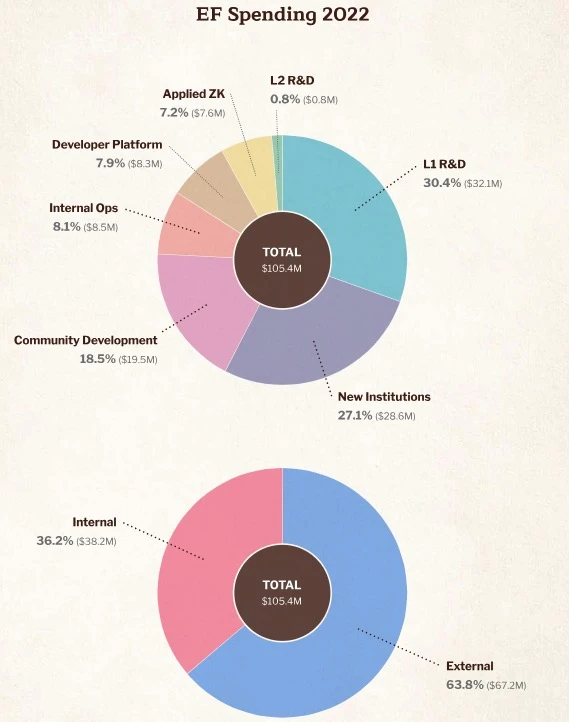
EF expenditure in 2023
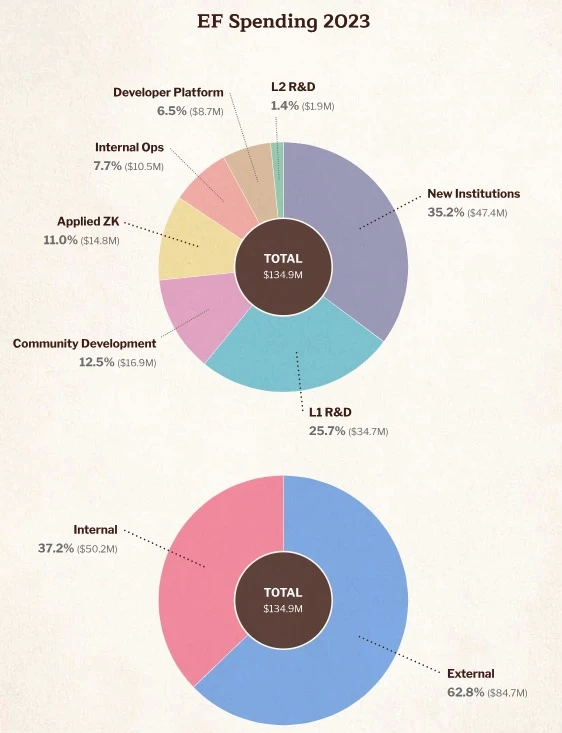
Expenditure Category Description
-
L1 RD: This category includes all RD related to mainnet upgrades, Geth, internal security research, cryptography RD, economic modeling and mechanism design, as well as long-term research to achieve the Ethereum community roadmap and provide funding to external execution and consensus layer clients. In addition, it also includes many other funding projects for external teams, such as network stress testing and external research in professional cryptography.
-
L2 RD: This includes support for internal teams who contribute to L2 research and development, and grants to external groups to improve the L2 ecosystem. These grants cover educational resources, block explorers, developer tools, security reviews, and more.
-
Applied ZK RD: This includes funding for the Privacy and Scalability Exploration Team, whose projects include MACI, Anon Aadhaar, TLS Notary, etc. In addition, multiple grants are provided, ranging from ZK development tools, ZK ceremony design user experience, to ZK application proof of concept.
-
Developer Platform: Covers all work related to improving Ethereum as a developer platform, including projects for libraries such as Solidity, Remix, Ethers.js, and Web3.js, as well as support for the Python ecosystem.
-
Community Development: This includes a variety of work supporting different parts of the Ethereum community, covering engagement with the core protocol community (such as supporting the staking community), the Next Billion team, Devcon and Devconnect events, Ethereum.org, and other educational resources. In addition, a number of grants have been provided to local and regional Ethereum communities and events around the world.
-
Internal Operations: Covers general expenses to support all teams at EF, including all costs associated with internal and external legal, accounting and finance services, as well as organization-wide subscriptions and service providers, such as data services, operational tools and technology infrastructure. Also included are investment costs related to fiscal management strategies, and salaries for all operational and administrative staff.
-
New Institutions: Includes funding for new institutions to support the Ethereum ecosystem. During 2022 and 2023, this includes funding for organizations such as the Nomic Foundation, 0x PARC, L2B EAT, etc.
Ethereum Foundation Treasury Reserve
As of October 31, 2024, the Ethereum Foundation (EF) holds a total treasury reserve of approximately $970.2 million, consisting of $788.7 million in crypto assets (including the remaining 26,701 ETH committed to customer incentive programs), and $181.5 million in non-crypto investments and assets.
The vast majority (99.45%) of crypto assets are held in the form of ETH. This ETH accounts for 0.26% of the total ETH supply on October 31, 2024.
We have chosen to hold the majority of our treasury reserves in ETH to reflect the Foundation鈥檚 confidence in Ethereum鈥檚 potential, and our ETH holdings also represent this long-term perspective.
At the same time, the goal of the Foundation鈥檚 treasury reserves is to provide financial support for important public products in the Ethereum ecosystem for many years to come.
To achieve this goal, we follow a conservative policy of treasury reserve management to ensure sufficient resources even in prolonged market downturns. This requires us to periodically sell ETH to ensure sufficient reserves for the next few years, while programmatically increasing fiat reserves during bull markets to support spending in bear markets.
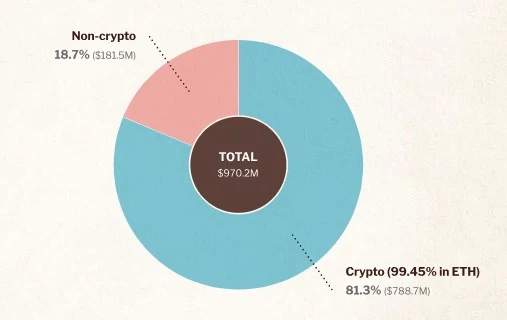
Ecosystem rises and meets challenges
Ethereum Ecosystem
Over the past few years, the Ethereum ecosystem has continued to grow. There are now many organizations and institutions contributing to Ethereum and pushing its boundaries forward, including companies, non-profits, DAOs, L2 organizations, and more. Our ecosystem has never been stronger.
As the ecosystem develops, these organizations are contributing more funds to the Ethereum community.
Total treasury volume of the Ethereum ecosystem
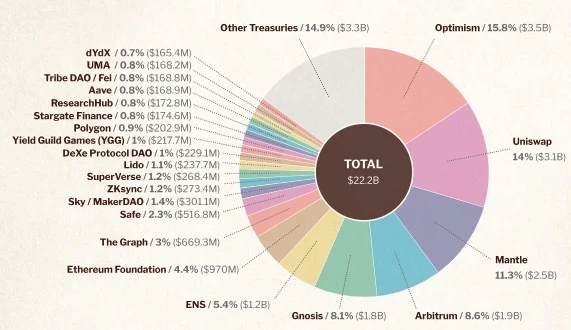
By 2024, the Ethereum ecosystem will be supported by billions of dollars in funding from foundations, organizations, and DAOs.
This chart shows the total value held in project treasuries. This includes both liquid amounts available to projects and amounts still vesting. All non-EF data is sourced from Deep DAO (deepdao.io/organizations) as of October 17, 2024.
Most project treasuries consist primarily of the project鈥檚 native token. This means that the total value of a project鈥檚 treasury is far greater than the total value that can be immediately deployed in fiat. If a project attempts to sell a significant portion of its treasury, it could have a significant impact on the price of the underlying token.
Instead, the graph shows us the depth of resources available to the Ethereum ecosystem in the long term. Even a small portion of the capital deployed incrementally over the next 10 years will provide significant resources for the development and maintenance of the Ethereum ecosystem.
Total funding for Ethereum ecosystem deployment in 2022-2023

In 2022 and 2023, organizations in the Ethereum ecosystem deployed a total of more than $497 million to support projects across the community.
When collecting this data, we used a broad เด็ดขาดnition of ecosystem funding. This includes funding for Ethereum public products (such as the protocol association), as well as funding for projects within the larger Ethereum ecosystem (for example, products funded to build on a specific L2). This data does not include equity investments or similar funding, nor does it include airdrops from token generation events.
Dollar values are calculated using applicable asset prices at the end of the year or the specific appropriation date when information is known.
This information was collected by researching public information and contacting 94 organizations in the Ethereum ecosystem. However, the existing data is fragmented, and some projects did not respond to our inquiries. The data also does not include the internal spending of many organizations, which often contribute to Ethereum public goods. The data should be considered incomplete.
We include data on grant distribution platforms such as Gitcoin. Funding associated with these platforms often comes from donations from other organizations such as EF. We de-duplicate the data whenever possible to avoid double counting.
This article is sourced from the internet: An overview of the Ethereum Foundation’s 2024 report: how much money is being raised and where is it being spent?
Related: 1051 days have passed since the last copycat season
Original article by Katherine Ross and David Canellis, Blockworks Original translation: BitpushNews Mary Liu The cryptocurrency market is hinting that altcoin season is about to set in. Sadly, we are not there yet. As with most things in this industry, there is rarely a formal definition that everyone agrees on. Does a Bitcoin bear market begin, like traditional finance, when a correction of more than 20% from a local top begins? Clearly not. Is the protocol decentralized because it has a governance token? If this is true, the project will not find everything difficult. Since the beginning of the month, the total cryptocurrency market capitalization has risen nearly 20%, or more than $360 billion, to $2.35 trillion. Altcoins account for about 40% of the total market cap, with the rest…







